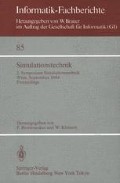Zusammenfassung
Bei der digitalen Simulation kontinuierlicher Systeme kommt sowohl den Simulationssprachen als auch den numerischen Methoden eine besondere Bedeutung zu. Die Wahl einer Simulationssprache stellt eine Entscheidung dar, die massgeblich darüber bestimmt, mit welchem Aufwand ein mathematisches Modell implementiert und das zugehörige Programm verifiziert werden kann, wie lesbar das Programm ist, wie leicht Aende-rungen des Modells und des Experiments möglich sind und weiteres mehr. Moderne Simulationssprachen, wie ACSL [1], CSSL-IV [2], DARE-P [3] usw., bieten eine Vielzahl von benutzerfreundlichen Attributen, was unter anderem zu wesentlich kürzeren Programmen führt als bei Verwendung höherer Programmiersprachen wie FORTRAN, ALGOL oder PASCAL.
Access this chapter
Tax calculation will be finalised at checkout
Purchases are for personal use only
Preview
Unable to display preview. Download preview PDF.
Referenzen
Advanced Continuous Simulation Language (ACSL) User Guide and Reference Manual Mitchell and Gauthier, Assoc. Concord, Mass., 1975
Continuous System Simulation Language (CSSL-IV) User Guide and Reference Manual Nilsen, Assoc.Chatsworth, California, 1976
Korn, GA, Wait, JV Digital Continuous-System Simulation Prentice-Hall, Englewood Cliffs, 1978
Ral1, LB Automatic Differentiation: Techniques and Applications Lecture Notes in Computer Science No. 120 Springer Verlag, Berlin, Heidelberg, New York, 1981
Halin, HJ “The Applicability of Taylor Series Methods in Simulation” Proceedings of the 1983 Summer Computer Simulation Conference, Vol. 2 (Supplement on State of the Art Issues in Simulation), North Holland Publishing Company, pp. 1032–1076, 1983
Knapp, H, Wanner, G “LIESE: A Program for Ordinary Differential Equations Using Lie-Series” MRC Tech. Summary Rept. No. 881 University of Wisconsin - Madison, 1968
Barton, D, Willers, IM, Zahar, RVM “Taylor Series Methods for Ordinary Differential Equations - An Evaluation” in Mathematical Software, J. Rice, Editor Academic Press, New York, pp. 369–390, 1971
Halin, HJ, Hepner, SAR “Solving Benchmark Problems with PSCSP and Other Simulation Languages” Proceedings of the 1984 Summer Computer Simulation Conference Boston, Mass., 1984
Mennig, J, Auerbach, T, Brunner, J, Halg, W, Halin, HJ “Integration of Differential Equations by Means of Lie-Series and Various Numerical Methods: Comparison of Speed and Reliability” Proceedings of the IAEA Seminar on Numerical Reactor Calculations IAEA, Vienna, Austria, pp. 157–182, 1972
Halin, HJ “Integration across Discontinuities in Ordinary Differential Equations Using Power Series” SIMULATION, pp. 46-53, 1976
Halin, HJ, Kriz, J “On the Accurate Treatment of Fixed and Variable Time Delays” Proceedings of the 1979 Summer Computer Simulation Conference Seattle, Wash., pp. 130–134, 1979
Halin, HJ “A Fast and Accurate Method for the Integration of Implicit Differential Equations and the Treatment of Algebraic Loops” accepted for publication in MATHEMATICS AND COMPUTERS IN SIMULATION
Halin, HJ, Bührer, R, Halg, W, Benz, H, Bron, B, Brundiers, H, Isacson, A, Tadian, M “The ETH-Multiprocessor Project: Parallel Simulation of Continuous Systems” SIMULATION, pp. 109–123, 1980
Bührer, RE, Brundiers, H, Benz, H, Bron, B, Friess, H, Halg, W, Halin, HJ, Isacson, A, Tadian, M “The ETH-Multiprocessor EMPRESS: A Dynamically Configurable MIMD System” IEEE Transactions on Computers, Vol. C–31, No. 11, pp. 1035–1044, 1982
Enright, WH “Studies in the Numerical Solution of Stiff Ordinary Differential Equations” Tech. Rept. 46, Dept. of Computer Science, Univ. of Toronto Toronto, 1972
Mennig, J, Auerbach, T, Halg, W “Two Point Hermite Approximations for the Solution of Linear Initial Value and Boundary Value Problems” Computer Methods in Applied Mechanics and Engineering, No. 39, pp. 199–224, 1983
Fatunla, SO “Numerical Integrators for Stiff and Highly Oscillatory Differential Equations” Mathematics of Computation, Vol. 34, No. 150, pp. 373–3 90, 1980
Author information
Authors and Affiliations
Editor information
Editors and Affiliations
Rights and permissions
Copyright information
© 1984 Springer-Verlag Berlin Heidelberg
About this paper
Cite this paper
Halin, H.J. (1984). Semianalytische Methoden in Der Simulatiostechnik. In: Breitenecker, F., Kleinbert, W. (eds) Simulationstechnik. Informatik — Fachberichte, vol 85. Springer, Berlin, Heidelberg. https://doi.org/10.1007/978-3-642-69706-7_1
Download citation
DOI: https://doi.org/10.1007/978-3-642-69706-7_1
Publisher Name: Springer, Berlin, Heidelberg
Print ISBN: 978-3-540-13393-3
Online ISBN: 978-3-642-69706-7
eBook Packages: Springer Book Archive

